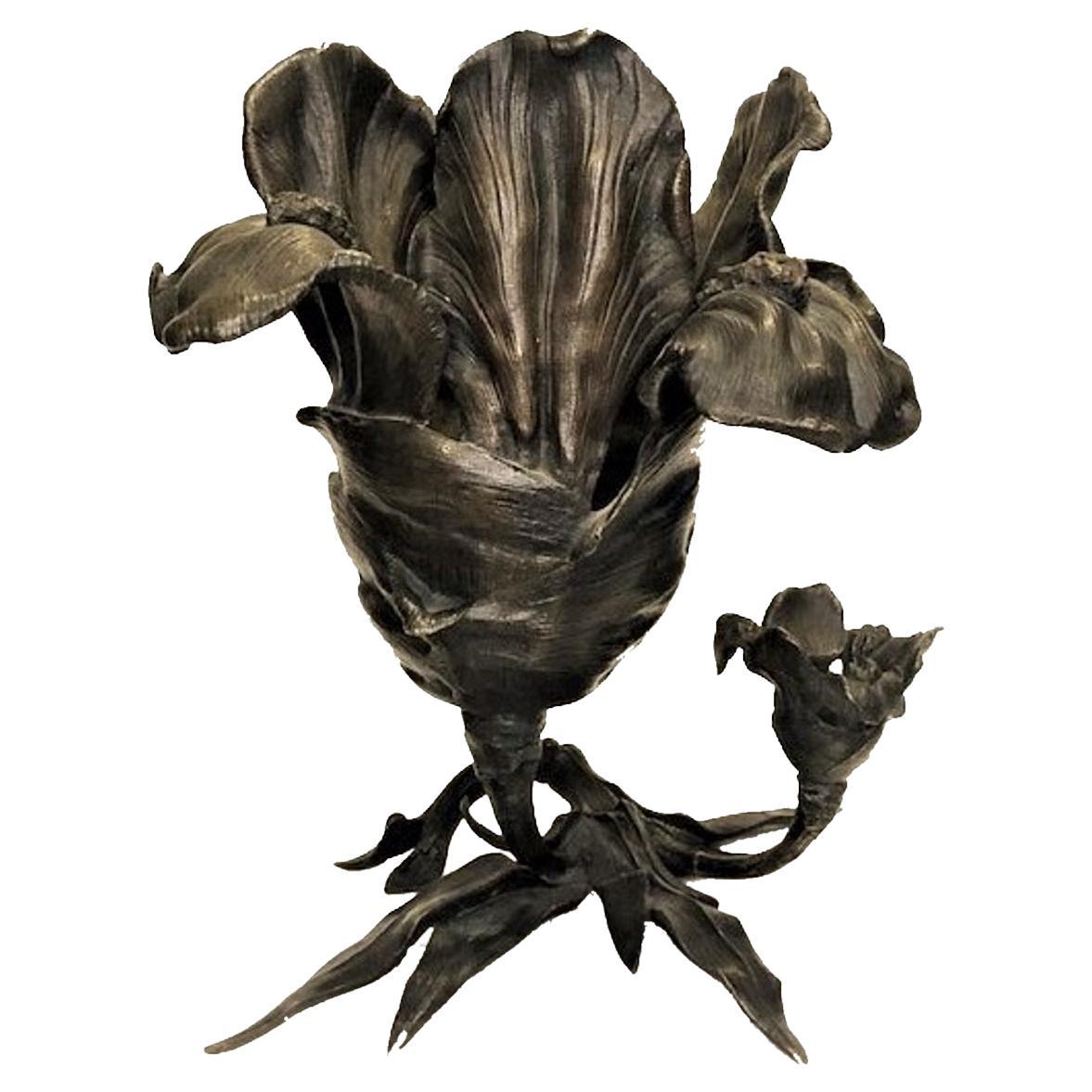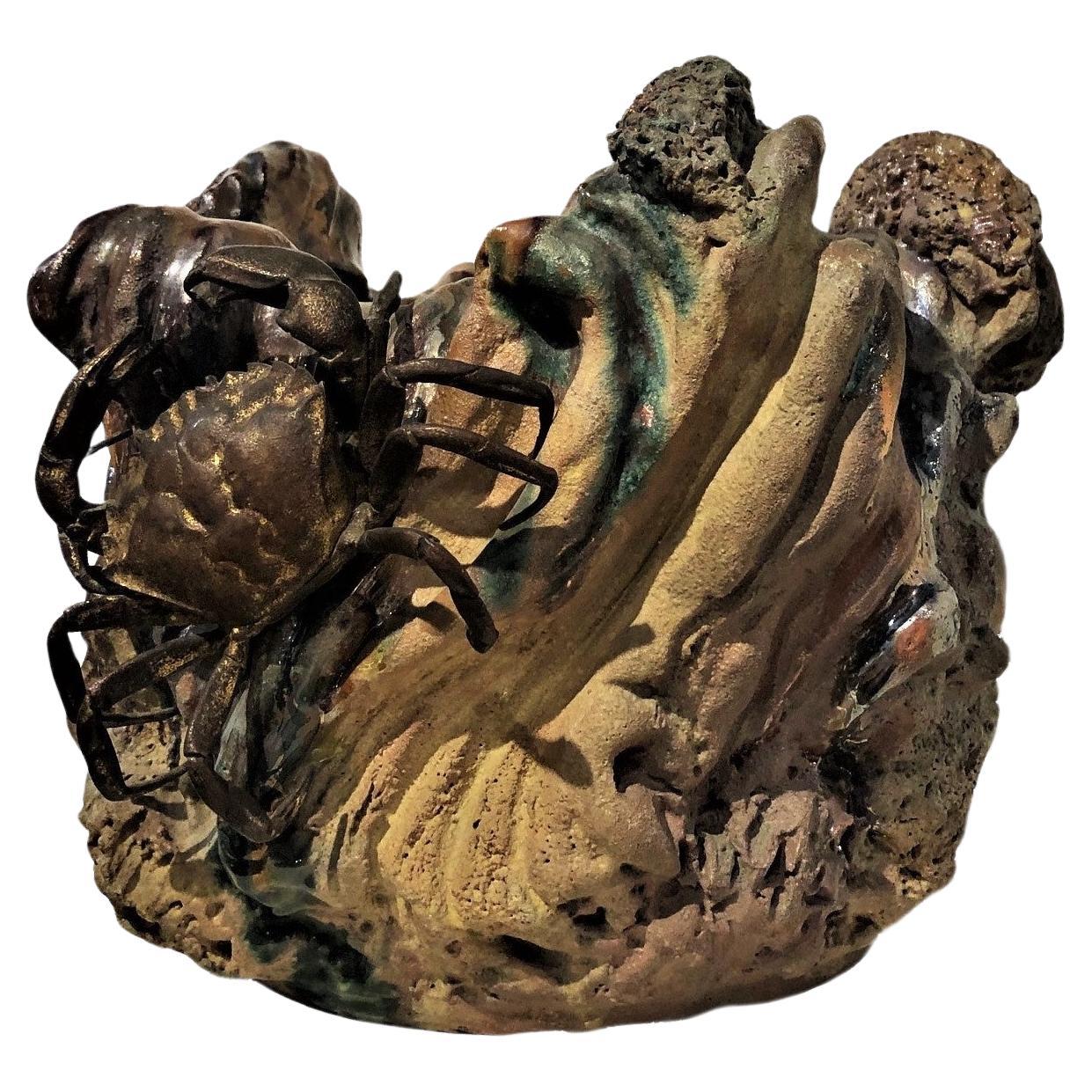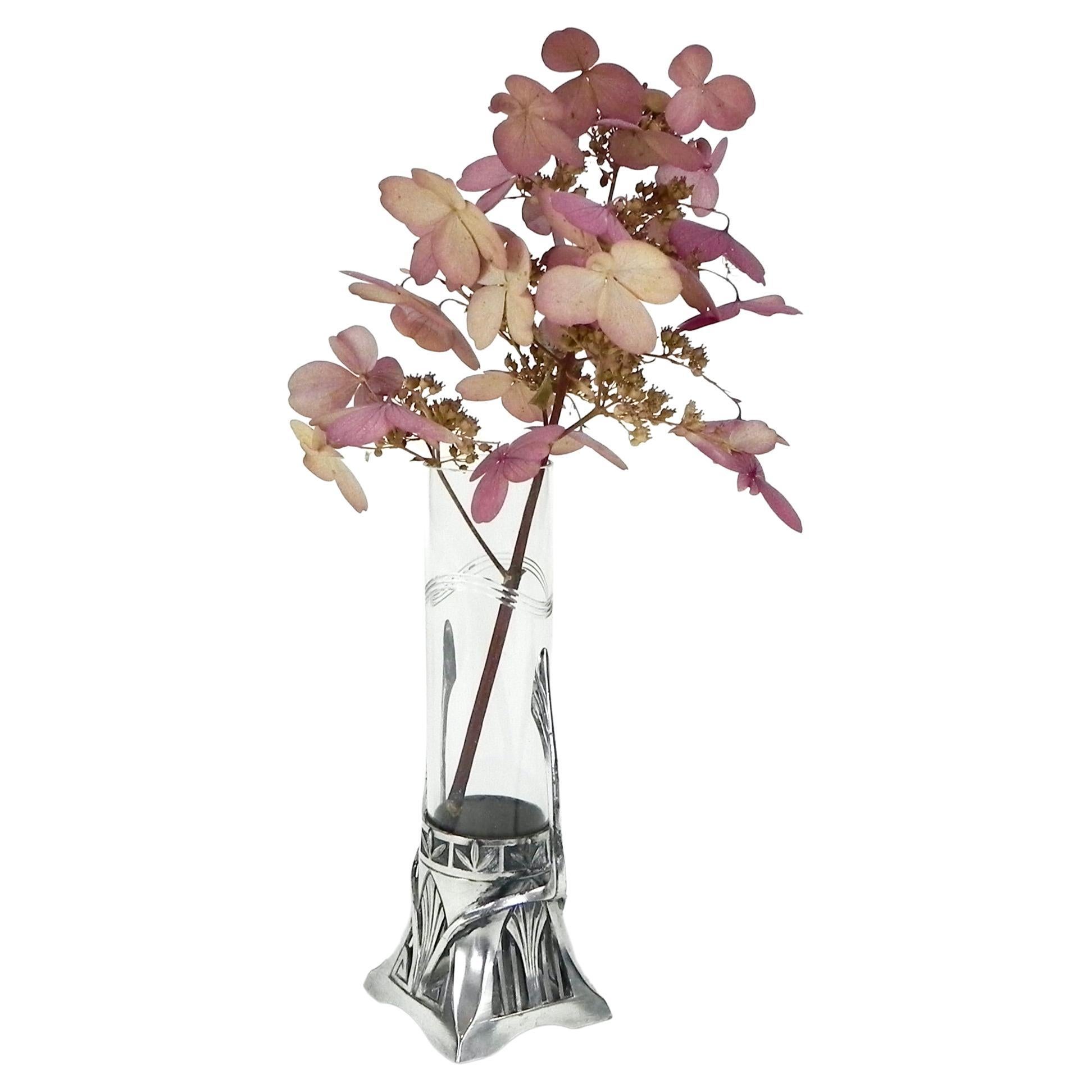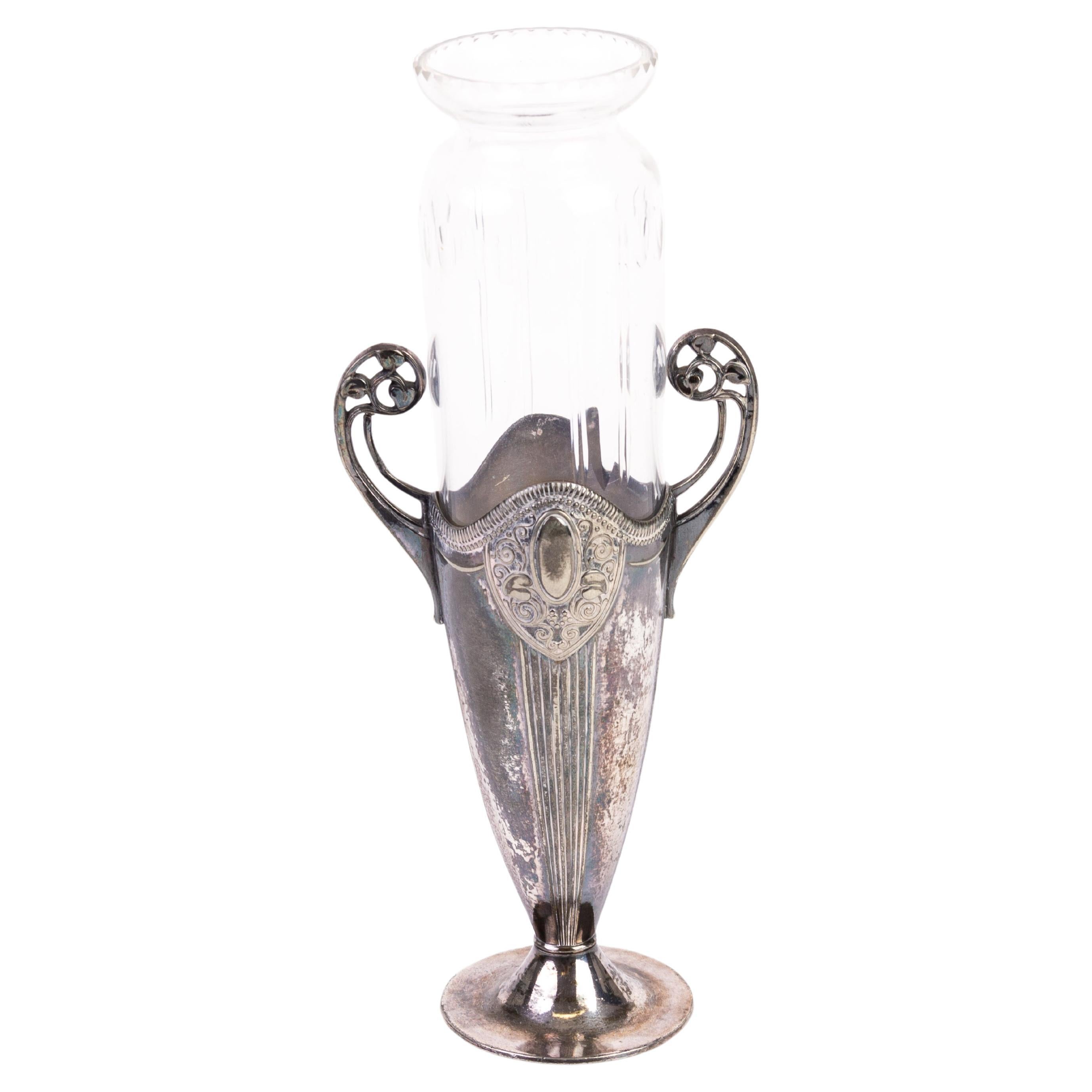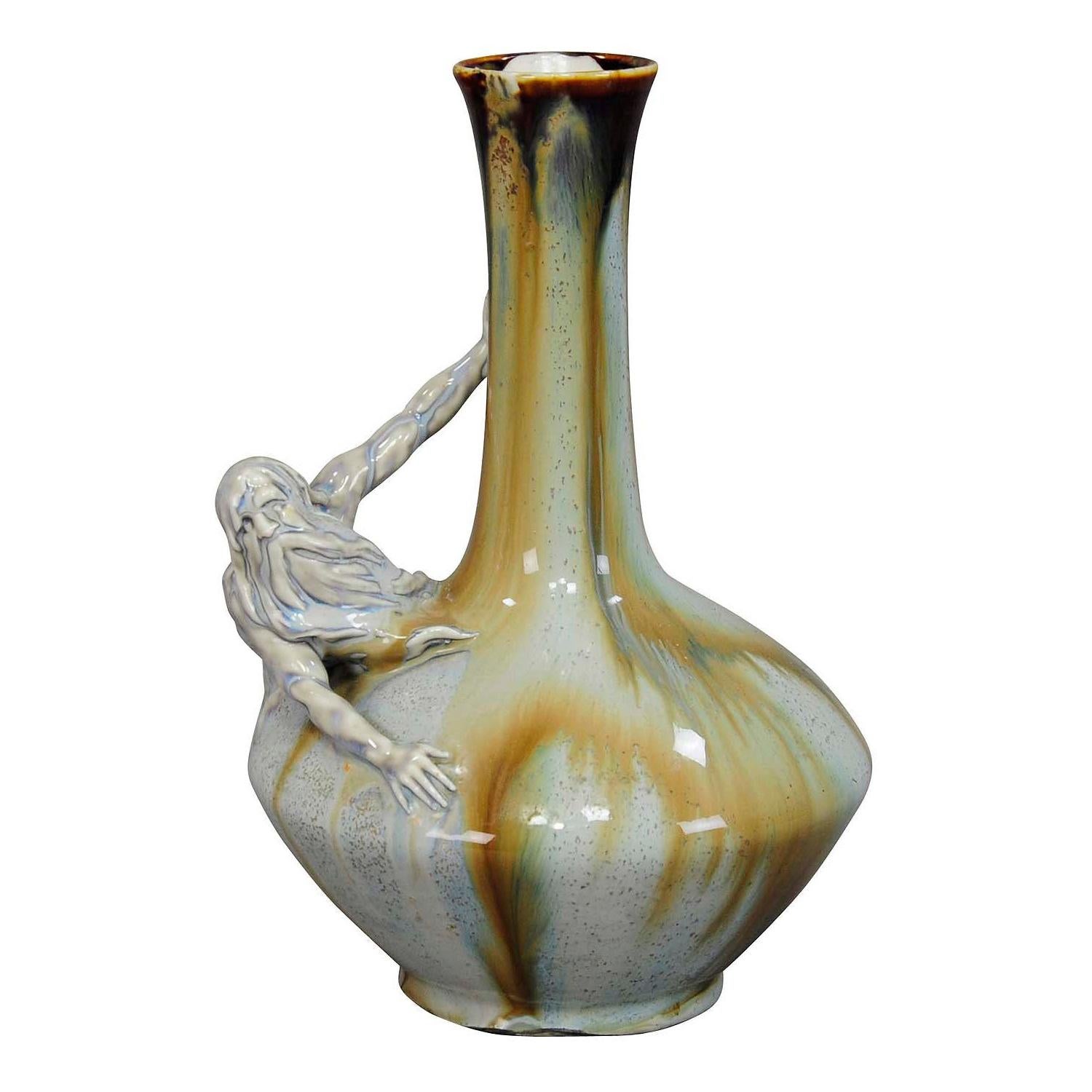Items Similar to French Art Nouveau pewter vase, ca 1900
Video Loading
Want more images or videos?
Request additional images or videos from the seller
1 of 10
French Art Nouveau pewter vase, ca 1900
About the Item
French Art Nouveau pewter vase, ca 1900
A French Art Nouveau vase, made of pewter in beautiful Art Nouveau scene of flowers, raised on 4 legs. A tapered, but rounded model with two arms, representing the stem of the plant with five flowered buds at the top. The vase has a small dent and a small cut in the rim on top of the vase
The measurement is 37.5 cm high, 17 cm wide and the depth is 13 cm
The weight is 1065 grams
- Dimensions:Height: 14.77 in (37.5 cm)Width: 6.7 in (17 cm)Depth: 5.12 in (13 cm)
- Style:Art Nouveau (Of the Period)
- Materials and Techniques:
- Place of Origin:
- Period:
- Date of Manufacture:ca 1900
- Condition:Wear consistent with age and use.
- Seller Location:Delft, NL
- Reference Number:
About the Seller
5.0
Platinum Seller
These expertly vetted sellers are 1stDibs' most experienced sellers and are rated highest by our customers.
Established in 1995
1stDibs seller since 2018
315 sales on 1stDibs
Typical response time: <1 hour
- ShippingRetrieving quote...Ships From: Delft, Netherlands
- Return PolicyA return for this item may be initiated within 7 days of delivery.
More From This SellerView All
- French Art Nouveau Pewter VaseLocated in Delft, NLFrench Art Nouveau pewter vase A pewter vase with flowers and an insect in Art Nouveau style with stones in blue, green striped glass. The...Category
Antique Early 1900s French Vases
MaterialsPewter
- Émile Gallé Miniature Cameo Vase, Art Nouveau, Ca 1900By Émile GalléLocated in Delft, NLÉmile Gallé miniature Cameo vase, Art Nouveau, ca 1900 Émile Gallé (Nancy, 1846 –1904) was a French glassmaker and furniture designer Émile Gallé 7...Category
Early 20th Century French Art Nouveau Vases
MaterialsGlass
- Émile Gallé small Cameo vase, Art Nouveau, ca 1900By Émile GalléLocated in Delft, NLÉmile Gallé small Cameo vase, Art Nouveau, ca 1900 Émile Gallé (Nancy, 1846 –1904) was a French glassmaker and furniture designer Émile Gallé 20 cm hig...Category
Early 20th Century French Art Nouveau Vases
MaterialsGlass
- French Art Nouveau furniture by Louis Chambry, ca 1900Located in Delft, NLFrench Art Nouveau furniture by Louis Chambry, ca 1900 An Art Nouveau set consists of a bookcase, mirror, desk with office chair and two separate chairs by Louis Chambry, France, ci...Category
Early 20th Century French Desks
MaterialsWalnut
- Art Nouveau French Bronze Wax Seal Stamp by Budin, ca 1900Located in Delft, NLArt Nouveau French bronze wax seal stamp by Budin, ca 1900. A lovely Art Nouveau bronze wax seal stamp of a woman figure, nude with long hair ...Category
Antique 19th Century French More Desk Accessories
MaterialsBronze
- French Art Deco bronze and Onyx mantelpieces, ca. 1920Located in Delft, NLFrench Art Deco bronze and Onyx mantelpieces, ca. 1920 Set of two decorative mantelpieces, made of bronze and Onyx. On a square black marble with an onyx square base, then tapering ...Category
Early 20th Century French Art Deco Vases
MaterialsOnyx, Bronze
You May Also Like
- French Art Nouveau Patinated Bronze Sculptural Iris Vase, ca. 1900Located in New York, NYABOUT IRIS The iris is a special and mysterious flower. Not only because of its striking appearance, but also from an artistic and historical point of view. It is also like a work of art, as though created by Mother Nature. The unique leaves of this plant not only create wonderful shadow casts, but also look as if they were painted by hand. It's no wonder that iris acts as the muse for countless artists, and can be seen in many famous works of art. The iris was first spotted in the time of Pharaoh Thutmose, in 1504 BC. He had the iris inscribed into the wall reliefs of a temple as a sign of his power, as well as decorating his sceptre with motifs of the flower. Since then, the iris has been a symbol of victory in Egypt. But the symbolism of the iris goes further than that. In Japan, the flower represents courage and is the symbol of the boys' festival. In Islamic cultures, the iris is a symbol of prosperity. In Europe, the flower was a popular weapon symbol in the Middle Ages and stood for chivalry. And in Christianity, the iris was seen as a symbol of the trinity because of its three-part flowers. With more than 300 varieties, the iris is now the most popular flower among growers and gardeners following the rose. Countless artists use the iris in their works and the flower is present in all eras. You can see the flower on furniture, vases, jewelry, fabrics, sculptures, coats of arms and much more. Did you know that the iris is also called the sword lily? It's not a coincidence that it used to symbolize physical and emotional pain and suffering caused by a weapon. We also see the flower in religious art, where it's often associated with Mary and Jesus. The iris is also associated with the Greek goddess Iris, where the flower symbolizes reconciliation and divine messages. This is also reflected in many paintings. Finally, the iris is also visible in Dutch and Flemish still-life paintings. This can be in a religious form, incorporated into an object or as a decorative flower. In the Art Nouveau art movement, the iris (along with other plants, such as the birch) was often used as an expression of feminine beauty. With its almost otherworldly appearance, the iris is perfectly suited to the Art Nouveau aesthetic and is featured in many well-known works of art. The poet of that era, Hermann Hesse...Category
Antique Early 1900s French Art Nouveau Planters, Cachepots and Jardinières
MaterialsBronze
- French Art Nouveau Iridescent Stoneware & Bronze Vase or Cachepot, ca. 1900sLocated in New York, NYFrench Art Nouveau Ocean Life Theme Vase Cachepot Iridescent Stoneware & Patinated Bronze Crab Appliqué ca. 1900s ABOUT We present here a most unusual and utterly decorative Fren...Category
Antique Early 1900s French Art Nouveau Vases
MaterialsStoneware
- Carl Deffner Art Nouveau Jegendstil Pewter Glass Vase circa 1900By Carl DeffnerLocated in Hampstead, QCCarl Deffner (1856-1948) Art Nouveau Jugendstil pewter and glass antique vase was made circa 1900 and is in excellent condition. No dents, missing p...Category
Antique Late 19th Century German Art Nouveau Vases
MaterialsPewter
- Art Nouveau Pewter VaseLocated in Nottingham, GBArt Nouveau Pewter Vase From a private English collection Free international shippingCategory
Early 20th Century Vases
MaterialsPewter
- Art Nouveau Porcellain Vase with Neptun Sculpture, ca. 1900Located in Berghuelen, DEA nice antique porcellaine vase in typical Art Nouveau style. With a protruding Neptun sculpture on the body. With blue and brown glaces. Manufactured...Category
Early 20th Century German Art Nouveau Vases
MaterialsPorcelain
- Art Nouveau Silvered Pewter Floor Vase by Hugo Leven, Germany 1900By Hugo LevenLocated in Vienna, ATArt Nouveau silvered pewter floor vase by Hugo Leven, Germany 1900. An ornamental floor vase designed by Hugo Leven featuring a female figure among gingko leaves. The vase is made of silvered pewter. Hugo Leven studied at the Kunstgewerbeschule and then at the Düsseldorf Art Academy. For some time he worked in his father Louis Leven's studio, had numerous contacts with French artists who influenced him greatly, and quickly became known. Engelbert Kayser hired him as the first employee in his studio. From 1895 to 1904 Leven designed numerous models for Kayserzinn; his works had a lasting influence on the pewter foundry of Art Nouveau. He also worked for the Kreuter company in Hanau and other companies that produced metal, silver and stoneware, such as B. Koch & Bergfeld and WMF. From 1904 to 1909 he lived in Bremen. In 1906, Leven's works were on display at the third German arts and crafts...Category
Early 20th Century German Art Nouveau Vases
MaterialsPewter
Recently Viewed
View AllMore Ways To Browse
Round Ca
Plant Model
Antique Bud Vase
Antique Bud Vases
Flower Bud Vase
Antique Pewter Vases
Pewter Vases Antique
Small Bud Vase
French Bud Vase
Art Nouveau Pewter Vase
Small Pewter Vases
Art Nouveau Bud Vase
Pewter Bud Vase
Italian Art Deco Bedroom Set
Large Daum Nancy
Sevres Lid
Vintage Bathroom Wall Art
Blue And Gold Dragon

